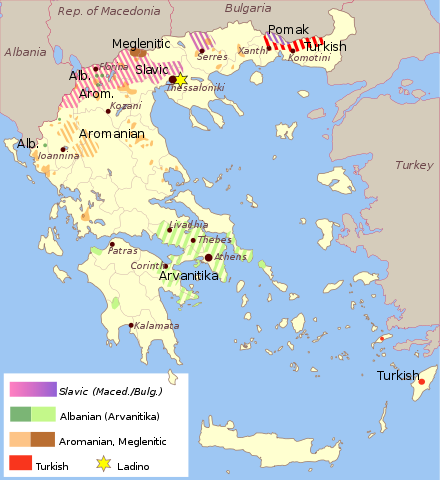 |
This is a file from the Wikimedia Commons. Information from its description page there is shown below.
Commons is a freely licensed media file repository. You can help.
|
| DescriptionGreece linguistic minorities.svg |
Areas with significant traditional presence of linguistic minorities in Greece ( Arvanitika, Albanian, Aromanian, Megleno-Romanian, Macedonian Slavic, Pomak Bulgarian, Turkish, Ladino)
- General outline and idea after a map at Ethnologue ( ) complemented and with some corrections from other sources:
- Aromanian data from Image:South-Balkan-Romance-languages.png by Yuri Koryakov, Wikipedia version of published work by the same author: Koryakov Y.B.: Atlas of Romance languages, Moscow, 2001. Map #8; based in turn on data in Kramer J. Rumnisch: "Areallinguistik II. Aromunisch", in: Lexikon der romanistischen Linguistik, ed. G. Holtus, M. Metzeltin, Ch. Schmitt. Tübingen, 1991, Bd. III.
- Further data from Euromosaic, Le [slavo-]macédonien / bulgare en Grèce , L'arvanite / albanais en Grèce , Le valaque/aromoune-aroumane en Grèce , and Mercator-Education: European Network for Regional or Minority Languages and Education, The Turkish language in education in Greece .
- Cf. also P. Trudgill, "Greece and European Turkey: From Religious to Linguistic Identity", in S Barbour, C Carmichael (eds.), Language and nationalism in Europe, Oxford University Press 2000.
- Albanophone villages near Florina according to: Riki Van Boeschoten (2001): Usage des langues minoritaires dans les départements de Florina et d’Aridea (Macédoine). Strates online, 10.
|
| Date |
23 February 2008, latest version 5 October 2008 |
| Source |
Own work |
| Author |
Future Perfect at Sunrise |
Permission
( Reusing this file) |
| Public domainPublic domainfalsefalse |
 |
I, the copyright holder of this work, release this work into the public domain. This applies worldwide.
In some countries this may not be legally possible; if so:
I grant anyone the right to use this work for any purpose, without any conditions, unless such conditions are required by law.Public domainPublic domainfalsefalse
|
|
 |
This SVG file uses embedded text that can be easily translated into your language using this automated tool. Learn more. You can also download it and translate it manually using a text editor.
|
File usage
The following pages on Schools Wikipedia link to this image (list may be incomplete):
This file contains additional information, probably added from the digital camera or scanner used to create or digitize it. If the file has been modified from its original state, some details may not fully reflect the modified file.
SOS Children aims to make Wikipedia suitable for young learners. SOS Childrens Villages believes education is an important part of a child's life. That's why we ensure they receive nursery care as well as high-quality primary and secondary education. When they leave school, we support the children in our care as they progress to vocational training or higher education. Will you help another child today?



